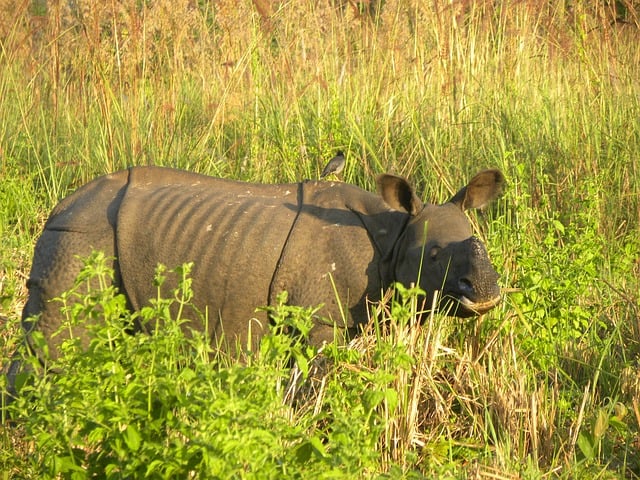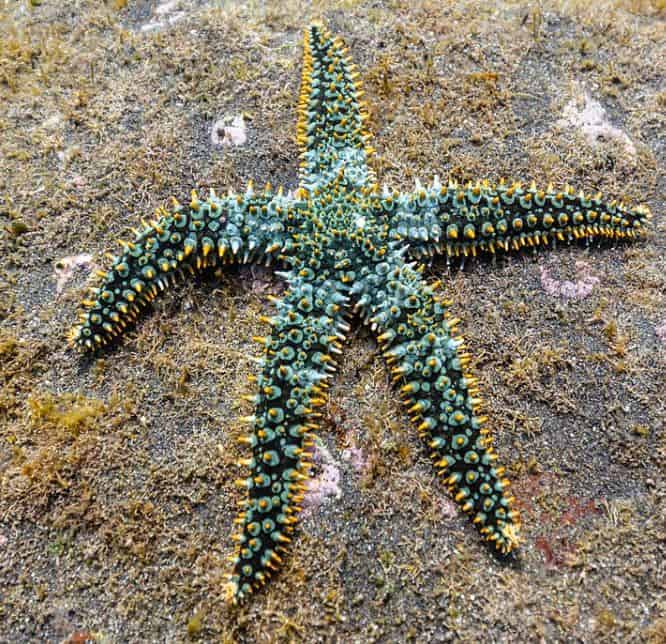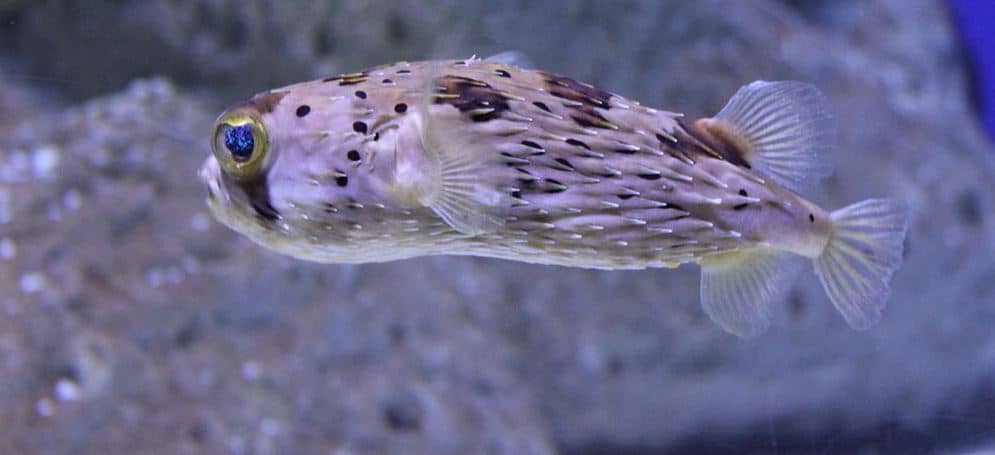Have you ever wondered about what animals have armor bodies and what its armored body is made from? If so, You are in the right place to explore them.
In this article, we will look at Animals with Armor, as well as types of armor, all of which have been chosen from various niches around the world.
Let’s see them to spark your curiosity about biology.
Table of Contents
Animals With Armor:
Armadillo: Armor of Osteoderm

Armadillo is a special animal that belongs to Class Mammalia, Order Cingulata, and is found in Central America, South America, and other places.
In Spanish, Armadillo literally means ‘little armored ones. These are the animals with armor on their body, that is, Its skin is protective in function as it has a shell-like skin made of bony plates called osteoderms that grow in the skin and are interconnected or held together by collagen fibrils. Its armor is present on its back, head, shoulder, hips, limbs, and tail. However, there is no armor or armored skin on its ventral surface or underside of its body.
Interestingly, Its skin is not bulletproof but protective in function against the thorn which they enter during a predator’s attack.
Pangolin: Armor of Scale

The Pangolin, also known as scaly anteaters, is a nocturnal mammal that belongs to Order Pholidota and is found in Asia, Africa and other countries.
They have armored bodies covered by scales that are hard, sharp, and are made of keratin, the same substance that is present in our human fingernails and claws of four-limbed animals. These scales cover their entire body except at the ventral surface. When they are threatened, they will roll into a ball shape by covering their face with their tails which are all covered by scales that are hard and sharp to face by the predators.
Interestingly, Its scales are soft when they are born and it becomes hard as they start to mature.
Read More: Animals With Human Teeth!
Indian Rhino: Armor of Thick Skin Folds

The Indian rhinoceros, also known as greater one-horned rhinoceros, great Indian rhinoceros, is an Asian rhinoceros that belongs to Genus Rhinoceros, Family Rhinocerotidae, and is found in Uttar Pradesh, West Bengal, and Assam.
An interesting thing about them is their unique skin that looks like a thick coat. They have thick skin with grey-brown color and pinkish skin folds on their body and wart-like bumps on their upper legs and shoulders. However, both male females have thick skin but the male has thicker skin and more folds at their neck than the female rhinos. Its skin fold is expected to lose excessive body heat or aids in regulating body temperature due to its maximum surface area.
Its skin thickness avoids and protects against serious injuries or complications. However, it does not protect against bloodsucking Tabanus flies, leeches, and ticks.
Crocodile: Armor of Osteoderm

The Crocodile is a carnivorous reptile that belongs to Family Crocodylidae, Order Crocodilia, and is found in Africa, Asia, the Americas, Australia, and other countries.
The surprising thing about crocodiles is they possess hard, thick skin with many rows of bony protrusion that can hurt other animals. Its skin has many rows of osteoderms, thick skin, scales with calcium deposits that provide protection, and are capable of balancing calcium balance in their body and during egg-shell formation, as they act as a reservoir of calcium minerals.
Really Interesting thing that makes you think twice about them is their hardness and skin can help in the absorption of the sunlight. The presence of these osteoderms makes their skin a little bit bulletproof.
Thorny devil: Armor of Spines

A thorny devil, also known as the mountain devil, thorny lizard, is a lizard species belonging to Genus Moloch, Family Agamidae. These animals are found in Australia, spinifex grasslands, South Australia, and western Queensland.
Names are what defines an animal, Now think of its names such as ‘Thorny devil’, ‘thorny lizard’, and ‘thorny dragon’ what do you think, is it devil, dragon, thorny lizard or a combination of these, As you can see, they have really sharp and uncalcified spines covering its entire body acting as an armor for them while also making difficult to handle or swallow by predators.
Interestingly, Its spiny skin acts as a sponge for water absorption that is transported to its mouth for drinking as there is a scarcity of water in their desert habitats.
Galapagos tortoise: Armor of Shell

The Galapagos tortoise, also known as Galapagos giant tortoise is a large-sized tortoise species belonging to Genus Chelonoidis, Family Testudinidae, and is found in Galapagos island.
One can notice the shells of a tortoise, especially the shell of a Galapagos tortoise, is a perfect example for the animals with armor as these shells are stronger while covering and protecting its body against any damages, and also against potential predators. Its shells are saddle-shaped along with a high notch above the neck.
Surprisingly, they are also able to withstand the weights, forces, and pressure exerted on them.
Armadillo Girdled Lizard : Armor of Scale and Spine

An armadillo girdled lizard, has many names such as the armadillo lizard, the Golden-armadillo lizard, and the armadillo spiny-tailed lizard is a lizard that belongs to Genus Ouroborus, Family Cordylidae, and is found in South Africa, and the western districts of South Africa.
Most people think of it as an armadillo because its part of the name refers to armadillo but it is not so. However, they are called so because they contain armor-like bodies similar to armadillos but being a lizard with a spiny body gives them many names. These are the lizards with the light brown-dark brown colored bodies that are covered by both scales and spines for protecting themselves from predators.
When they are in danger, They can roll into a ring shape to make themselves large and hard to swallow by predators due to its hard and sharp spines.
Leatherback sea turtle: Armor of Shell (Pseudo Shell)

A leatherback sea turtle, also known as the lute turtle, leathery turtle, or simply the luth, is a large-sized turtle that belongs to Genus Dermochelys, Family Dermochelyidae, and is found across the Atlantic, Pacific Oceans, and other regions.
Fortunately, They look like they have hard shells on their body. However, they don’t possess any shells. Its body does not have any bony shell structure to protect them. However, Its carapace is covered by oily flesh, flexible, leather-like shiny skin that resembles armor or shell.
Interestingly, most of them manage to thrive successfully without being attacked by predators because of their huge body size, about 250-750 kg. Most juveniles and nesting females have predators such as jaguars, killer whales, great white sharks, and tiger sharks.
Horned lizard : Armor of Scales

A Horned lizard, also known as horny toads, horntoads, is a lizard species that belongs to Genus Phrynosoma, Family Phrynosomatidae, and is found in northern Mexico, Texas, Oklahoma, Kansas, and New Mexico.
These have an armor of spines, modified scales that are hard and sharp enabling them protection against predators. It has flattened, rounded bodies, blunt snouts, and red brown-yellow grey colors that enable the camouflage ability while its head has true horns because it contains a bony core-that’s a really interesting feature.
They can squirt blood through their eyes about 5 feet away. Its blood tastes foul to canine, feline, and other predators causing them to lose interest to attack them again. However, Its blood has no effect on some birds of prey so these lizards become larger by puffing their bodies to make themselves harder to swallow by birds.
Spiny Starfish: Armor of Spines or Thorns

A Marthasterias, also known as spiny starfish, crown-of-thorns starfish, is a group of starfish in the Genus Marthasterias, Family Asteriidae, and is found in the eastern Atlantic Ocean and other places.
They have the armor of spines as their body and arms are all covered by conical-shaped whitish spines with a purple-colored tip.
These spines on them look like thorns so these starfish are referred to as crown-of-thorns starfish. Its spines serve many functions including preventing attacks from predators.
Dentalium: Armor of Tooth Shell

A Dentalium, also known as tooth shells, elephant’s tusk, elephant’s tooth, or tusk shells, is a group of marine molluscs that belongs to Family Dentaliidae and is usually found on the sea beds, Pacific coast of North America, Southeast Alaska, Western Canada, and other oceans.
These are special molluscs which possess armor of tusk, a body covered by long tusk-like structures that are usually long, curved, and white in color.
They can extend their long feet out of the tusks for digging the seafloor, for locomotion, and while feeding on microscopic organisms, detritus and foraminiferans.
Spiny Bush Viper: Armor of Scale

A spiny bush viper, also known as a rough-scaled bush viper, spiny bush viper, or hairy bush viper, is a venomous viper species that belong to Genus Atheris, Family Viperidae, and is found in Central Africa, Asian regions, and other places.
They have the armor of scale, a modified dorsal scales that are sharp, pointed, and bristly appearance covers its entire bodies. It has about 15 circumorbital scales around its eyes, elongated and heavily keeled dorsal scales on its bodies, a single anal scale, 15–19 rows of dorsal scales on its midbody, and about 150 ventral scales.
Surprisingly, The males of the spiny bush viper are longer and slender than the females. However, both possess enough scales that are all distributed on their bodies and protect them against their predators such as other snakes, birds of prey, and others.
Lionfish: Armor of Venomous Spines

A lionfish, also known as firefish, turkeyfish, butterfly-cod, is a group of venomous marine fish in the Family Scorpaenidae, Order Scorpaeniformes and is found in oceans of the Indo-Pacific, and the Red Sea.
They have the armor of venomous spines, modified pectoral fins that contain venom, and are red-white in colors. There are about 18 venomous spines in total, that are originated from two pelvic spines, three anal spines, and 13 dorsal spines.
They manage to ward off the predators without actually engaging in the fights because of brilliant colored spines along with contrasting stripes. However, Its venomous spines are also capable of killing the predators if they approach them.
Long-Spine Porcupinefish: Armor of Spines

A long-spine porcupinefish, also known as the freckled porcupinefish, is a nocturnal fish that belongs to Family Diodontidae, Order Tetraodontiformes, and is found in Florida, eastern Pacific oceans, Mediterranean Sea, San Diego, California, Galapagos Islands, Massachusetts, and Brazil.
They possess armor of spines that are longer and deeply rooted spines distributed on their entire bodies.
When they feel threatened, Its spines are erected by these fishes as they inflate their bodies by swallowing water. However, When they are calm and relaxing its spines are usually resting in position as they are parallel to their body surfaces and pointing towards their tails.
